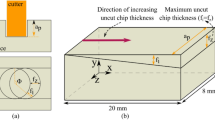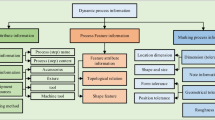Abstract
Cutting parameters are important components in the process of computer numerical control (CNC) machining, and reasonable choice of cutting parameters can significantly affect the energy efficiency. This paper presents a multi-objective parameter optimization method for energy efficiency in CNC milling process. Firstly, the energy consumption composition characteristics and temporal characteristics in CNC milling are analyzed, respectively. The energy model of CNC milling is then established, of which the correlation coefficient is obtained through nonlinear regression fitting. Then a multi-objective optimization model is proposed to take the highest energy efficiency and the minimum production time as the optimization objectives, which is solved based on Tabu search algorithm. Finally, a case study is conducted to validate the proposed multi-objective optimization model and the optimal parameter solutions of maximum energy efficiency and minimum production time is obtained. Moreover, the parametric influence on specific energy consumption and production time are explicitly analyzed. The experiment results show that cutting depth and width are the most influential parameters for specific energy consumption, and spindle speed ranks the first for the production time.













Similar content being viewed by others
Abbreviations
- CNC:
-
Computerized numerical control
- TS:
-
Tabu search
- SEC:
-
Specific energy consumption
- GRA:
-
Grey relational analysis
- RSM:
-
Response surface method
- MRR:
-
Material removal rate
- MRV:
-
Material removal volume
- NP-hard:
-
Non-deterministic polynomial hard
References
Balogun, V. A., & Mativenga, P. T. (2013). Modelling of direct energy requirements in mechanical machining processes. Journal of Cleaner Production, 41(2), 179–186.
Bhushan, R. K. (2013). Optimization of cutting parameters for minimizing power consumption and maximizing tool life during machining of Al alloy SiC particle composites. Journal of Cleaner Production, 39(1), 242–254.
Calvanese, M. L., Albertelli, P., & Matta A., et al. (2013). Analysis of energy consumption in CNC machining centers and determination of optimal cutting conditions. In Proceedings of the 20th CIRP international conference on life cycle engineering (pp. 17-19). Singapore.
Campatelli, G., Lorenzini, L., & Scippa, A. (2014). Optimization of process parameters using a response surface method for minimizing power consumption in the milling of carbon steel. Journal of Cleaner Production, 66(2), 309–316.
Camposeco-Negrete, C. (2013). Optimization of cutting parameters for minimizing energy consumption in turning of AISI 6061 T6 using Taguchi methodology and ANOVA. Journal of Cleaner Production, 53(16), 195–203.
Carcangiu, S., Fanni, A., & Montisci, A. (2008). Multiobjective Tabu search algorithms for optimal design of electromagnetic devices. IEEE Transactions on Magnetics, 44(6), 970–973.
Chelouah, R., & Siarry, P. (2000). Tabu search applied to global optimization. European Journal of Operational Research, 123(2), 256–270.
Energy Consumption Survey (MECS) (2013) Total consumption of electricity by manufacturing industry and region. Technical report, US Energy Information Administration.
Gutowski, T., Dahmus, J., & Thiriez, A. (2006). Electrical energy requirements for manufacturing processes. In Proceedings of 13th CIRP international conference on life cycle engineering. Belgium: Leuven, May 31– June 2.
Hanafi, I., Khamlichi, A., Cabrera, F. M., et al. (2012). Optimization of cutting conditions for sustainable machining of PEEK-CF30 using tin tools. Journal of Cleaner Production, 33(8), 1–9.
Hedberg, E. C., & Ayers, S. (2015). The power of a paired t test with a covariate. Social Science Research, 50, 277–291.
Hu, S. H., Liu, F., He, Y., et al. (2010). Characteristics of additional load losses of spindle system of machine tools. Journal of Advanced Mechanical Design, Systems and Manufacturing, 4(7), 1221–1233.
Kant, G., & Sangwan, K. S. (2014). Prediction and optimization of machining parameters for minimizing power consumption and surface roughness in machining. Journal of Cleaner Production, 83, 151–164.
Kara, S., & Li, W. (2011). Unit process energy consumption models for material removal processes. CIRP Annals Manufacturing Technology, 60(1), 37–40.
Kong, D., Choi, S., Yasui, Y., et al. (2011). Software-based tool path evaluation for environmental sustainability. Journal of Manufacturing Systems, 30(4), 241–247.
Kuram, E., Ozcelik, B., Bayramoglu, M., et al. (2013). Optimization of cutting fluids and cutting parameters during end milling by using D-optimal design of experiments. Journal of Cleaner Production, 42(3), 159–166.
Li, L., Liu, F., Chen, B., & Li, C. B. (2015). Multi-objective optimization of cutting parameters in sculptured parts machining based on neural network. Journal of Intelligent Manufacturing, 26(5), 891–898.
Li, C. B., Tang, Y., Cui, L. G., et al. (2013). A quantitative approach to analyze carbon emissions of CNC-based machining systems. Journal of Intelligent Manufacturing, 26(5), 1–12.
Liu, F., Xu, Z. J., & Dan, B. (1995). Energy performance of mechanical processing system and application. Beijing: China Machine Press.
Li, W., Zein, A., Kara, S., & Herrmann, C. (2011). An investigation into fixed energy consumption of machine tools. In J. Hesselbach & C. Herrmann (Eds.), Glocalized solutions for sustainability in manufacturing (pp. 268–273). Berlin: Springer.
Mori, M., Fujishima, M., Inamasu, Y., et al. (2011). A study on energy efficiency improvement for machine tools. CIRP Annals Manufacturing Technology, 60(1), 145–148.
NBSC. (2010). China statistical yearbook. Beijing, China Statistics Press.
Rajemi, M. F., Mativenga, P. T., & Aramcharoen, A. (2010). Sustainable machining: Selection of optimum turning conditions based on minimum energy considerations. Journal of Cleaner Production, 18, 1059–1065.
Salonitis, K., & Ball, P. (2013). Energy efficient manufacturing from machine tools to manufacturing systems. Procedia Cirp, 7(12), 634–639.
Simoneau, A., & Meehan, J. (2013). The impact of machining parameters on peak power and energy consumption in CNC end milling. Energy and Power, 3(5), 85–90.
Valera, H. Y., & Bhavsar, S. N. (2014). Experimental investigation of surface roughness and power consumption in turning operation of EN 31 alloy steel. Procedia Technology, 14, 528–534.
Velchev, S., Kolev, I., Ivanov, K., et al. (2014). Empirical models for specific energy consumption and optimization of cutting parameters for minimizing energy consumption during turning. Journal of Cleaner Production, 80, 139–149.
Wang, Q., Liu, F., & Wang, X. (2013). Multi-objective optimization of machining parameters considering energy consumption. International Journal of Advanced Manufacturing Technology, 71(5–8), 1133–1142.
Yi, Q., Tang, Y., Li, C. B., & Li, P. Y. (2013). Optimization of CNC machine processing parameters for low carbon manufacturing. Proceedings of IEEE 9th conference on automation science and engineering (pp. 498–503). Wisconsin, USA: Madison.
Yoon, H. S., Lee, J. Y., Kim, M. S., et al. (2014). Empirical power-consumption model for material removal in three-axis milling. Journal of Cleaner Production, 78, 54–62.
Yoon, H. S., Moon, J. S., Pham, M. Q., Lee, G. B., & Ahn, S. H. (2013). Control of machining parameters for energy and cost savings in micro-scale drilling of PCBs. Journal of Cleaner Production, 54, 41–48.
Acknowledgments
This work was supported in part by the National High-Tech R&D Program of China under Grant 2014AA041506, and the National Natural Science Foundation of China (NSFC) under Grant 51475059.
Author information
Authors and Affiliations
Corresponding author
Rights and permissions
About this article
Cite this article
Li, C., Li, L., Tang, Y. et al. A comprehensive approach to parameters optimization of energy-aware CNC milling. J Intell Manuf 30, 123–138 (2019). https://doi.org/10.1007/s10845-016-1233-y
Received:
Accepted:
Published:
Issue Date:
DOI: https://doi.org/10.1007/s10845-016-1233-y




